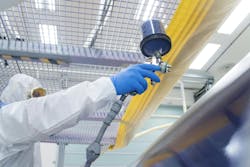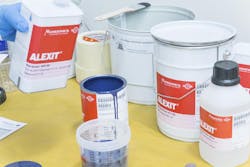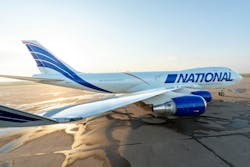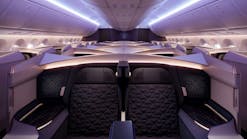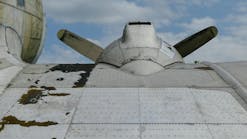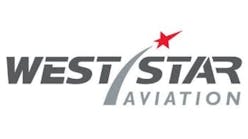What’s the Difference Between Epoxy and Polyurethane Paint?
In the specialized world of aircraft coatings, choosing the right paint is crucial for both performance and aesthetics. Gunnar Hansen, Executive Managing Director - Head of R&D Aviation Coatings at Mankiewicz Coatings, provides valuable insights into the key differences between epoxy (EP) and polyurethane (PUR) paints, their applications, and their advantages.
Understanding the fundamental distinctions between epoxy and polyurethane paints is the first step in making an informed choice for aircraft applications. Hansen explains, “Epoxy-based primers are typically used for structural parts of an aircraft due to their superior adhesion and corrosion protection.” This is essential for areas like the cargo compartment, where durability is critical.
Epoxy paints contain a free hydroxyl group (-OH) and an aromatic structure, enabling them to form strong bonds with metal surfaces. This characteristic is vital for maintaining adhesion and providing corrosion protection over the aircraft's lifespan, often exceeding 30 years. However, epoxy’s downside is its poor UV resistance, which makes it unsuitable for exterior surfaces exposed to sunlight.
On the other hand, polyurethane paints excel in UV resistance and aesthetics. “Polyurethane-based coatings cannot provide the level of adhesion to metal that epoxy primers do, but they offer superior UV protection and aesthetic qualities,” Hansen notes. This makes PUR the preferred choice for exterior applications, where maintaining gloss and color over time is paramount.
Application Processes
The application processes for EP and PUR paints also differ significantly, particularly regarding temperature sensitivity. “Epoxy systems require a minimum application temperature of 15°C, while polyurethane systems are more versatile and can be applied at lower temperatures,” Hansen points out. This flexibility makes PUR paints more suitable for varied climatic conditions, especially in repair and refurbishment scenarios.
Both EP and PUR systems can be applied using standard equipment, but Mankiewicz emphasizes the importance of proper training to ensure optimal application. Hansen highlights, “Our training programs are designed to help applicators achieve the best results, whether at the customer’s premises or at our facilities.”
Environmental conditions such as temperature and humidity play a significant role in the performance of these coatings. EP systems require consistent temperature conditions to perform optimally, while PUR systems offer greater adaptability. Hansen explains, “Polyurethane systems can be tailored to suit different temperatures and speeds, which is particularly beneficial in repair situations where quick turnaround is necessary.”
Safety is paramount when working with these materials. “Isocyanates used in polyurethane systems require special handling and training in Europe to ensure safety,” Hansen advises. Mankiewicz also offers isocyanate-free systems to address these concerns, highlighting the company's commitment to safety and innovation.
Durability and Lifespan
When it comes to durability, both EP and PUR systems are engineered for longevity. Epoxy primers are designed to last the aircraft's entire service life, providing long-term adhesion and corrosion protection. “The combination of EP primers with PUR topcoats ensures both structural integrity and aesthetic longevity,” says Hansen. Mankiewicz’s ALEXIT BaseCoat/ClearCoat system, for instance, has been monitored for over 13 years, maintaining its gloss and extending the aircraft’s repaint life.
The quality of raw materials used, is essential for ensuring performance and reliability of EP and PUR paints. Hansen remarks, “The focus should be on the essential properties that contribute to the longevity, safety, and aesthetic appeal of the aircraft.”
In terms of aesthetics, PUR systems are the top performers. They offer a higher degree of formulation freedom, allowing for adjustments in gloss level and finish quality. “Polyurethane systems provide a premium high gloss finish and excellent UV resistance, essential for maintaining the aircraft’s appearance,” Hansen emphasizes.
For repairs and touch-ups, PUR systems are more advantageous due to their faster curing times and lower temperature requirements. “The reaction of PUR systems can be accelerated by catalyzers, saving time during the application process,” Hansen explains. This makes PUR more suitable for unplanned repairs where quick turnaround is critical.
Recommendations for Different Applications
Hansen recommends epoxy primers for structural components due to their unmatched adhesion and corrosion protection. For exterior surfaces, polyurethane paints are ideal for their UV resistance and aesthetic qualities. This combination ensures that aircraft not only perform well but also look impeccable over their lifespan.
By understanding the distinct properties and advantages of epoxy and polyurethane paints, businesses in the aircraft industry can make informed decisions that enhance both the performance and appearance of their aircraft.
Application Processes
The application processes for EP and PUR paints also differ significantly, particularly regarding temperature sensitivity. “Epoxy systems require a minimum application temperature of 15°C, while polyurethane systems are more versatile and can be applied at lower temperatures,” Hansen points out. This flexibility makes PUR paints more suitable for varied climatic conditions, especially in repair and refurbishment scenarios.
Both EP and PUR systems can be applied using standard equipment, but Mankiewicz emphasizes the importance of proper training to ensure optimal application. Hansen highlights, “Our training programs are designed to help applicators achieve the best results, whether at the customer’s premises or at our facilities.”
Durability and Lifespan
When it comes to durability, both EP and PUR systems are engineered for longevity. Epoxy primers are designed to last the aircraft's entire service life, providing long-term adhesion and corrosion protection. “The combination of EP primers with PUR topcoats ensures both structural integrity and aesthetic longevity,” says Hansen. Mankiewicz’s ALEXIT BaseCoat/ClearCoat system, for instance, has been monitored for over 13 years, maintaining its gloss and extending the aircraft’s repaint life.
Environmental conditions such as temperature and humidity play a significant role in the performance of these coatings. EP systems require consistent temperature conditions to perform optimally, while PUR systems offer greater adaptability. Hansen explains, “Polyurethane systems can be tailored to suit different temperatures and speeds, which is particularly beneficial in repair situations where quick turnaround is necessary.”
Safety is paramount when working with these materials. “Isocyanates used in polyurethane systems require special handling and training in Europe to ensure safety,” Hansen advises. Mankiewicz also offers isocyanate-free systems to address these concerns, highlighting the company's commitment to safety and innovation.
While both EP and PUR paints are high-cost due to the quality of raw materials used, this investment is essential for ensuring performance and reliability. Hansen remarks, “The focus should be on the essential properties that contribute to the longevity, safety, and aesthetic appeal of the aircraft.”
In terms of aesthetics, PUR systems are the top performers. They offer a higher degree of formulation freedom, allowing for adjustments in gloss level and finish quality. “Polyurethane systems provide a premium high gloss finish and excellent UV resistance, essential for maintaining the aircraft’s appearance,” Hansen emphasizes.
For repairs and touch-ups, PUR systems are more advantageous due to their faster curing times and lower temperature requirements. “The reaction of PUR systems can be accelerated by catalyzers, saving time during the application process,” Hansen explains. This makes PUR more suitable for unplanned repairs where quick turnaround is critical.
Recommendations for Different Applications
Hansen recommends epoxy primers for structural components due to their unmatched adhesion and corrosion protection. For exterior surfaces, polyurethane paints are ideal for their UV resistance and aesthetic qualities. This combination ensures that aircraft not only perform well but also look impeccable over their lifespan.
By understanding the distinct properties and advantages of epoxy and polyurethane paints, businesses in the aircraft industry can make informed decisions that enhance both the performance and appearance of their aircraft.
